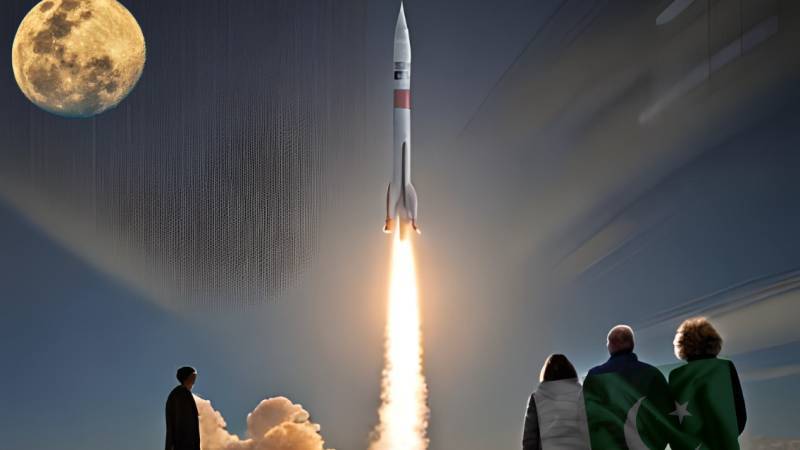
In the 21st century, aerospace power has proven to be vital for security and economic growth of several economies globally. The sector has evolved rapidly alongside advances in air and space technologies.
In today’s geo-political and geo-economic contexts, the aerospace sector encompasses everything from commercial aviation, manned and unmanned aircraft, and spacecraft manufacturing, as well as exploration and development of technology related to Earth’s atmosphere and outer space. It is critical for developing countries like Pakistan to leverage high-tech air and space technology as a game changer not only for advancement in an innovation-driven economy, but also for technological growth, which strengthens national security, and fosters strategic autonomy.
Pakistan’s burgeoning aerospace sector represents an untapped frontier in the pursuit of economic development. Globally, the aerospace industry is projected to grow at an estimated annual rate of 8.4% to reach $461.9 billion by 2028, from its current value of approximately $308.7 billion. Irrefutably, the rise of new technologies and augmented access to space has increased the significance of aerospace power in national security and global influence.
Pakistan is making strides in aerospace through efforts of the Pakistan Air Force (PAF). By investing in and developing cutting-edge technologies, the PAF has been enhancing its capabilities and promoting a bigger defence strategy aimed at safeguarding Pakistan’s airspace and supporting its strategic goals. The PAF is aligning itself with technological advancements, and driving innovation in the domains of cyber space, aviation, and artificial intelligence (AI).
By focusing on developing indigenous satellite technology through focused research and development, and foresighted policies, Pakistan can considerably increase its capabilities and application of satellite data in both military and civilian domains, facilitating environmental monitoring, telemedicine, remote learning, forensics, and navigation
The PAF is focusing on indigenisation and modernisation to foster self-reliance, bolster its defence posture, and expand its influence throughout the region. The acquisition of fifth-generation stealth fighter jets, rapid adoption of High Altitude Long Endurance (HALE) and Medium Altitude Long Endurance (MALE) unmanned aerial vehicles (UAVs), cutting-edge integrated air defence systems, air mobility platforms, and hypersonic missile capabilities, altogether illustrates PAF’s use of novel doctrines and tactics to improve national security and technology-driven strategies in modern warfare.
The PAF is also exploring innovation in economy by generating high-tech jobs, and supporting the aerospace as well as Information and Communications Technology (ICT) industries through the National Aerospace Science and Technology Park (NASTP). The National Incubation Centre for Aerospace Technologies (NICAT) is South Asia and Middle East’s first DeepTech and aerospace incubator, established by NASTP in partnership with the Ministry of Information Technology and Telecommunications (MoIT&T), is altering Pakistan’s technological landscape. With an emphasis on high-tech and aerospace, NICAT is appropriately positioned to capitalise on Pakistan’s aerospace potential by giving access to cutting-edge production facilities, research and development (R&D) centres, specialised equipment, and international marketing networks.
Additionally, space technologies such as remote sensing, navigation, and communication have emerged as key economic drivers. According to a report by the World Economic Forum (WEF), the space economy is surpassing the expansion of global GDP, with an average annual growth rate of 9%.
It is pertinent to note that Pakistan has launched eight satellites, including PakSAT-1R commercial satellites, remote sensing satellites such as PRSS-1 and PakTES-1A that are crucial for economic growth. Two recent developments include the launch of Pakistan’s first lunar satellite iCube-Qamar and operationalisation of PakSAT-MM1 multi-mission satellite for communication services in collaboration with China. Moreover, NASTP is also working on satellite technology and will soon launch a satellite.
Considering the pivotal role space technologies play in national security, disaster management, and socio-economic development, Pakistan must prioritise the expansion of its space efforts, build its capabilities, and leverage space technology to drive an innovation-led economy. Pakistan can overcome historical financial constraints through effective space commercialisation strategies and prioritising high-return investment areas like satellite launches, remote sensing, and space telecommunications.
Furthermore, by focusing on developing indigenous satellite technology through focused R&D, and foresighted policies, Pakistan can considerably increase its capabilities and application of satellite data in both military and civilian domains, facilitating environmental monitoring, telemedicine, remote learning, forensics, and navigation.
In addition to this, Public-Private Partnerships (PPPs) can be a powerful catalyst for innovation and progress in space initiatives. International examples, such as China’s collaborations with the private sector benefitted lunar exploration, and NASA’s partnership with Boeing and SpaceX for sending astronauts to the International Space Station (ISS), demonstrate the benefits of PPPs in space exploration and cost-efficiency. To promote private sector participation in commercial air and space endeavours in Pakistan, supportive policies must be harnessed. This will also stimulate innovation and entrepreneurship by attracting investment and fostering collaboration.
In conjunction with addressing contemporary security threats and emerging needs, a country’s aerospace sector confers prestige on the political and economic fronts. Pakistan’s recent advances in aerospace technology indicate a potential path for innovation and advanced capabilities. By prioritising R&D and PPPs, nationally and internationally, Pakistan can create a strong foundation for a thriving space industry and maximising economic benefits.

